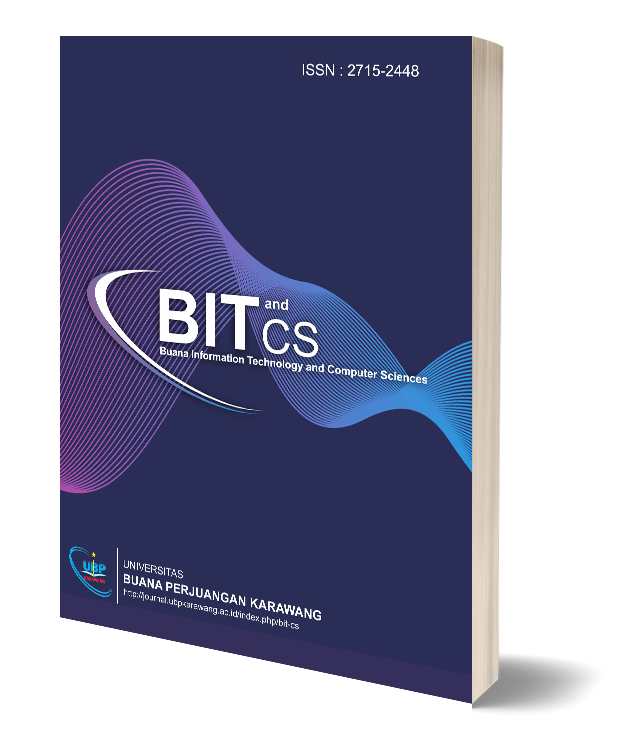Detecting Harmful Activity in Pilgrimage Using Deep Learning
DOI:
https://doi.org/10.36805/bit-cs.v4i1.2929Keywords:
Artificial Intelligence, Computer vision, Classification, Real-Time Object RecognitionAbstract
CCTV surveillance is the most extensively used intelligent latest innovation. The use of surveillance cameras has risen dramatically because of the convenience of monitoring from anywhere and the reduction of crime rates in public areas. In this paper, we introduce the idea of bad vibe activity detection from live videos to enhance the security and safety of pilgrims. The proposed bad vibes activity recognition model is intended to be addressed in the most efficient manner possible using cutting-edge technologies such as TensorFlow and Keras. TensorFlow was chosen because the project could be deployed to a mobile environment in the future with the possibility of extension of other areas such as airport security, bus stain, and public areas that may deserve special attention for security checks. We choose MediaPipe Holistic for employee bad vibe recognition in the model.
Downloads
References
R. K. Tripathi, A. S. Jalal, and S. C. Agrawal, "Suspicious human activity recognition: a review," Artificial Intelligence Review, vol. 50, pp. 283-339, 2018
A. Tapus, A. Bandera, R. Vazquez-Martin, and L. V. Calderita, "Perceiving the person and their interactions with the others for social robotics–a review," Pattern Recognition Letters, vol. 118, pp. 3-13, 2019.
A. Ilidrissi and J. K. Tan, "A deep unified framework for suspicious action recogni-tion," Artificial Life and Robotics, vol. 24, pp. 219-224, 2019.
Konstantinidis, D., Dimitropoulos, K., & Daras, P. (2018). Sıgn Language Recognıtıon Based On Hand And Body Skeletal Data. 2018- 3DTV-Conference: The True Vision - apture, Transmission and Display of 3D Video (3DTVCON).
S. J. Elias, S. M. Hatim, N. A. Hassan, L. M. A. Latif, R. B. Ahmad, M. Y. Darus, and A. Z. Shahuddin, "Face Recognition Attendance System Using Local Binary Pattern (LBP)," Bulletin of Electrical Engineering and Informatics, vol. 8, 2019.
A. Krizhevsky, I. Sutskever, and G. E. Hinton, "Imagenet classification with deep con-volutional neural networks," Advances in neural information processing systems, vol. 25, pp. 1097-1105, 2012
Genemo, M. D. (2022). Suspicious activity recognition for monitoring cheating in ex-ams. Proceedings of the Indian National Science Academy, 1-10.
C. A. Devine and E. D. Chin, "Integrity in nursing students: A concept analysis," Nurse education today, vol. 60, pp. 133-138, 2018.
H. M. Abdulghani, S. Haque, Y. A. Almusalam, S. L. Alanezi, Y. A. Alsulaiman, M. Irshad, et al., "Self-reported cheating among medical students: An alarming finding in a cross-sectional study from Saudi Arabia," PloS one, vol. 13, p. e0194963, 2018.
M. A. Lewis and C. Neighbors, "An examination of college student activities and atten-tiveness during a web-delivered personalized normative feedback intervention," Psy-chology of Addictive Behaviors, vol. 29, p. 162, 2015.
RWTH-PHOENIX-2014-T veri seti, https://wwwi6.informatik.rwth-aachen.de/~koller/RWTH-PHOENIX- 2014-T/
S. Balocco, M. González, R. Ñanculef, P. Radeva, and G. Thomas, "Calcified plaque detection in IVUS sequences: Preliminary results using convolutional nets," in Interna-tional Workshop on Artificial Intelligence and Pattern Recognition, 2018, pp. 34-42
Y. Liu, X. Wang, L. Wang, and D. Liu, "A modified leaky ReLU scheme (MLRS) for topology optimization with multiple materials," Applied Mathematics and Computation, vol. 352, pp. 188-204, 2019
J. Bouvrie, "Notes on convolutional neural networks," Neural Nets, MIT CBCL Tech Report, pp. 47-60, 2006.
Y. Li, Z. Hao, and H. Lei, "Survey of convolutional neural network," Journal of Com-puter Applications, vol. 36, pp. 2508- 2515, 2016.
A. Divakaran, Q. Yu, A. Tamrakar, H. S. Sawhney, J. Zhu, O. Javed, et al., "Real-time object detection, tracking and occlusion reasoning," ed: Google Patents, 2018.
A. Booranawong, N. Jindapetch, and H. Saito, "A system for detection and tracking of human movements using RSSI signals," IEEE Sensors Journal, vol. 18, pp. 2531-2544, 2018.
A. B. Mabrouk and E. Zagrouba, "Abnormal behavior recognition for intelligent video surveillance systems: A review," Expert Systems with Applications, vol. 91, pp. 480-491, 2018.
Krizhevsky and G. Hinton, "Learning multiple layers of features from tiny images (Technical Report)," University of Toronto, 2009
D. K. Vishwakarma, "A two-fold transformation model for human action recognition using decisive pose," Cognitive Systems Research, vol. 61, pp. 1-13, 2020.
M. A. Khan, Y.-D. Zhang, S. A. Khan, M. Attique, A. Rehman, and S. Seo, "A re-source conscious human action recognition framework using 26-layered deep convolu-tional neural network," Multimedia Tools and Applications, pp. 1-23, 2020.
Downloads
Published
Issue
Section
License

This work is licensed under a Lisensi Creative Commons Atribusi-BerbagiSerupa 4.0 Internasional.




